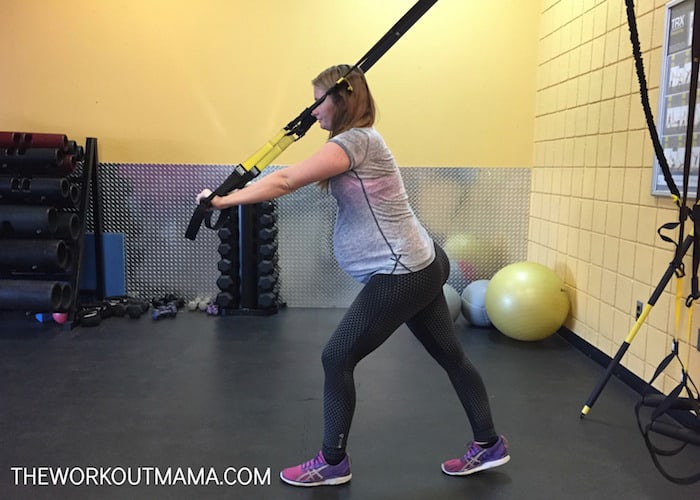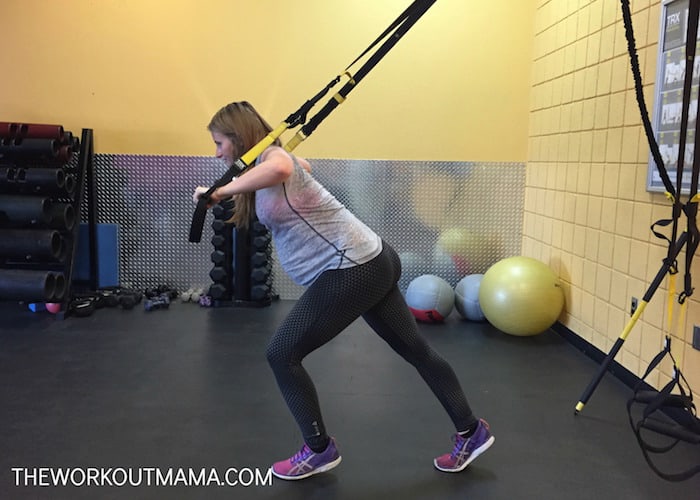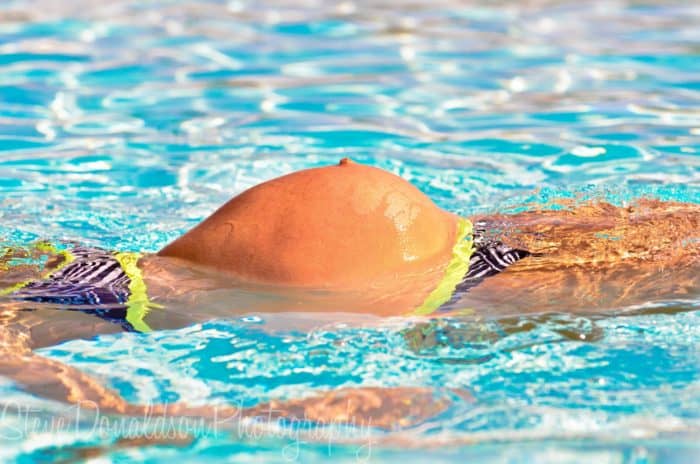Disclaimer: I feel the need to put a disclaimer on this post and let you know I am by no means a medical professional. I am however a mother, certified personal trainer, and yoga instructor. What I am sharing is based on my own research and experience. This post also contains affiliate links.
I am in my third trimester of pregnancy with my third baby. Never thought I would type that, to see why watch VASECTOMIES, FOSTER PARENTING, & A PREGNANCY TEST. Over the last 5 years of being pregnant three times I have learned as much as could about pregnancy and exercise.
I am a certified personal trainer, and yoga instructor, and also a nutrition coach. I also know there are many trainers and fitness professionals in the world who have way more knowledge than I do but don’t have the experience of having been pregnant three times. Here is what I have learned over the last several years about exercising while pregnant.
Your First Pregnancy is NOT the Same as Your Second (or Third)
Your first pregnancy is amazing for many reasons. You can nap when you are tired being one of them. But in all seriousness, during your first pregnancy your body is being stretched for the first time in a new way. Your muscles, ligaments, tendons, organs, and bones have never had the pressure of carrying and holding a baby before.
My first pregnancy I exercised very similarly to how I was exercising before I become pregnant. I adopted the motto “If you were doing it before you were pregnant it is safe to do the same while pregnant“. While this may be true for certain activities I wish I would have had more knowledge of what exactly I was doing to my body.
During my first pregnancy I did lots of yoga. I was already very flexible before pregnancy and with the added hormones I became even more flexible. I don’t think yoga is necessarily a bad way to move while pregnant, but I do think you need to be extra cautious about the poses that you do.
When I became pregnant the second time I was shocked by how my body felt. I was so uncomfortable. I couldn’t do even half of what I had been able do when I was pregnant the first time.
The best way I can describe multiple pregnancies on your body is to think of a deflated balloon. The first time you attempt to blow air into the balloon it will feel like you are going to pass out. The balloon has never been inflated before. The next time it is inflated you don’t have to work as hard.
With the body the same thing happens. The fascia surrounding the muscles, tendons, ligaments, and organs has already been manipulated in the same way previously making it easier to move, which is good and bad. Your body was made to adapt to pregnancy, but if you already have instability in areas of the body they will become even more noticeable and potentially problematic for you.
Hire a Trained Professional
These people are worth the money. Trust me. I spent several months working with a physical therapist after having my second baby and was so sad when I was recovered because I wanted to keep working with him.
While my physical therapist was a male and had obviously never been pregnant he had way more training than a personal trainer and could evaluate the imbalances in my body.
Personal trainers are wonderful. I am certified personal trainer. But our scope of knowledge is limited. We do not have the same training as a physical therapist.
Most insurance plans will cover multiple physical therapy visits. If you have been pregnant and something in your body still does not feel right these are great professionals to go and see.
Diastasis Recti & Healing Your Pelvic Floor after Baby
Women who have given birth – can we just get a moment of silence for all the times we have accidentally peed our pants during a workout. Jump ropes, box jumps, and jumping jacks, I am specifically looking at you. If this is you, there is a solid chance your body has yet to fully recover from having a baby.
Looks can be deceiving. Your tummy might be flat at 6 weeks postpartum but that doesn’t mean that your pelvic floor and abdominal muscles have fully healed.
I mention this because the way you exercise while pregnant can worsen your abdominal separation. Don’t be like me and let your ego get in the way! It isn’t worth it. Again, just because you can do something doesn’t mean that you should.
No matter how many months or even years it has been since having a baby there is hope to heal your pelvic floor and abdominal muscles!I highly recommend the MuTu System for those wanting to heal their core and pelvic floor after giving birth. You can read about my experience with the Mutu System HERE.
Exercises to Avoid While Pregnant
These are the exercises I see recommended by trainers or #fitspo #fitmom Instagrammers that literally make me want to cry. Please, please, please if you are pregnant avoid these exercises. It is only for 9 months of your life and I promise your body will thank you in the years to come.
Even if these exercises can be performed it doesn’t mean that they should. This is a lesson I learned the hard way. Your body is going to change while you are pregnant. Abdominal separation is normal and how you exercise while you are pregnant can improve your recovery after pregnancy.
LUNGES
Most of us, personal trainers included, do not always have perfect form when exercising. For this reason alone, my advice is to avoid lunges after the first trimester. Be very careful with any unilateral exercise, like lunges, during pregnancy because of the risk of low back, hip and knee issues. In my opinion this exercise is not worth the risk of developing imbalances in the body.
Pregnancy Safe Alternative: Squats
Squats are great during pregnancy, just make sure that you have your feet and knees fairly narrow, narrower than you may have done them before, and ensure that you keep your knees in line with your feet. This is to protect your knees and hips, which are more vulnerable during pregnancy because of the horemone relaxin. Also, if you feel too much strain on your back, use a stability ball on a wall for support.
PLANKS & PUSHUPS
Planks and Pushups are beneficial exercises to do, but need to be done mindfully. You can place your hands on a bench, table, stairs, or even against the wall to modify this exercise. Planks should be avoided after the first trimester.
Pushups can be modified during the entire pregnancy. When you look at your midsection while you are doing this you should see more of a gradually rounding. If you see a bulge in the middle elevate your hands further from the floor. There is no shame elevating your pushup.
Pregnancy Safe Alternative: Bird Dog & TRX Chest Press
Bird Dog: Come to a hands and knees position on an exercise mat positioning your knees underneath your hips and the crease of your wrists directly underneath your shoulders. Your fingers should be pointing forward. Engage your core and abdominal muscles. Keep your spine in a neutral position, avoid any excessive sagging or arching. Pull the shoulder blades toward your hips. In this exercise you are attempting to move the opposite arm and leg simultaneously. It is very helpful to use a mirror to help you with form adjustments. Begin by slowly lengthening the left leg until it is long and strong. Lift the leg off the floor until it is at or near parallel to the floor. The leg should not be lifted above hip height. This will help to avoid upward rotation at the hip. That might be enough. If it feels comfortable you can lift the right arm as well. Another option is to lift the leg and arm separately and switch sides.
TRX Chest Press: Grab the handles and take a step forward on one leg. Keeping your body in a straight line and both arms straight, lean froward until your body is at about a 40 degree angle. Bend the elbows and lower your body. Use your arms to push yourself back to the starting position.
SITUPS, CRUNCHES, AND OTHER ABDOMINAL EXERCISES
According to the American Congress of Obstetricians and Gynecologists the average distribution of weight gain during pregnancy is 30 pounds. This increase in weight causes internal pressure inside of the abdominal cavity. The pressure is upward, downward, and outward and is what creates the abdominal separation. The entire core of the body, glutes, ribs, pelvic floor, and the deeper core musculature become unstable.
This can lead to low back pain, pelvic pain, incontinence, prolapse and urinary urgency/frequency. Women who have abdominal separation also tend to have a higher degree of pelvic floor and abdominal pain.
Avoid these all together.
BOX JUMPS
As mentioned before pregnant women release a hormone called Relaxin which causes ligaments to be looser and can affect balance. Therefore, movements such as box jumps should be avoided after the first trimester. Plus they really don’t feel all that great anyway when you are pregnant.
LOWER BODY UNILATERAL MOVEMENTS
Now some trainers will tell you that lower body unilateral movements (lunges, single leg deadlifts, etc.) are an excellent way to train the body while pregnant. Their reason is that these exercises are great stabilizers and improve balance. I do not disagree that these are great exercises, but I cannot recommend them during pregnancy. It is better to keep both feet together and under the hips for improved balance and stability during pregnancy than it is to try and improve your overall balance and stability. Your chance of injury is higher with these types of movements and they should be avoided, especially after the first trimester.
TWISTING MOVEMENTS
Don’t twist or compress your abdomen torso and spine. No twisting yoga poses. Just don’t do it.
RUNNING
I have some friends who can run while they are pregnant. Personally, I feel like my body is falling apart mid stride and the next day I can barely walk. I learned during my second pregnancy that running and pregnancy, at least for me, are not a great combination. Running is very high impact.
The best prenatal exercise routine is to perform exercises that are low impact and will not create further imbalances in your body. Don’t be afraid to lift weights, increase your heart rate, and work up a sweat! These are all great things for you do.
Exercise Intensity, Heart Rate, & Rate of Perceived Exertion
Over the years the recommendations issued by the American College of Obstetrics and Gynecology (ACOG) on pregnancy and exercise intensity have dramatically changed:
- 1985: The ACOG issues a statement that the maximum heart rate during pregnancy should not exceed 140 beats per minute and women should not participate in strenuous exercise for more than 15 minutes.
- 1994: A new statement is released removing specific limitations regarding exercise during pregnancy. The ACOG said, ‘‘there is no data in humans to indicate that pregnant women should limit exercise intensity and lower target heart rate because of adverse effects.’’ They still recommended that women avoid exhaustion during exercise.
- 2002: The ACOG published ‘‘Exercise During Pregnancy and the Postpartum Period: ACOG Committee Opinion 267.’’ In this paper, the ACOG Committee recognizes that ‘‘in the absence of contraindications, pregnant women should be encouraged to engage in regular, moderate intensity physical activity to continue to derive health benefits during their pregnancy as they did prior to their pregnancy.’’
It has been many years since the maximum heart rate during pregnancy was recommended not to exceed 140 beats per minute. If a doctor or trainer tells you otherwise there is a good chance they are sharing outdated information. What you want to be mindful of is not allowing your body to become overheated to the point that it can not cool itself down.
If you regularly exercise with a heart rate monitor you can continue to do so while pregnant or you can evaluate your intensity using the Rate of Perceived Exertion (RPE), or how you feel based on a scale from one to ten. As a general rule, keep your RPE in the 5-6 range during pregnancy workouts.
Your 5-6 RPE pre-pregnancy will not feel the same as your 5-6 while you are pregnant. During pregnancy the body produces more blood and the heart works harder to circulate the excess. The increase in blood is responsible for fatigue, nausea and dizziness during the first trimester.
General Tips for Exercising while Pregnant
Remember to drink plenty of water and stay hydrated before, during, and after exercise. Dealing with dehydration is not fun when you are pregnant. I learned this the hard way with my second pregnant and ended up in the hospital twice.
Find out what works best for you. For me and my third pregnancy this has looked liked swimming laps, incline walking on the treadmill, lifting weights, and stretching.
Once you reach the third trimester be extra cautious and careful with your movements. During your final weeks of pregnancy your uterus is 500 times its normal size. You’re carrying around an extra 20 to 40 pounds, making even the simplest movements a workout. Enter the gym with zero ego to ensure you are as safe as possible.
Properly warm up and cool down as this will help to reduce the risk of injury.
If you feel dizzy or lightheaded at any time discontinue your current activity and give your body time to recover. This will happen sometimes due to increased blood flow.
High risk activities should be avoided. If you road bike avoid the risk of becoming off balanced by finding a indoor cycle class. Any risk or trauma that could potentially happen to the abdomen should be placed on hold until after you deliver.
Be mindful of the amount of time you spend on your back. The added weight of the baby can place more stress on your spine.
Dealing with varicose veins? Be sure to read the following post Varicose Veins & Pregnancy for more on this topic.
Wear comfortable clothes that aren’t overly tight especially around your waist. My favorites include: Lululemon Studio Pants, Lucy Get Going Pants, Reebok Studio Pants, Lululemon Tech Shirts, and Reebok Burnout Shirts.
Hopefully this post was helpful and encouraging to you! Let me know what you think. How was your experience exercising while pregnant?

















